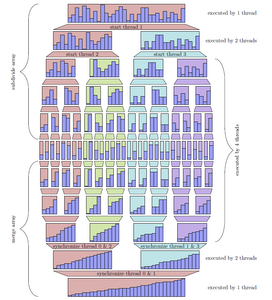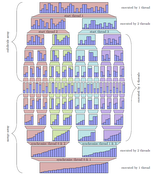Information
- Publication Type: Bachelor Thesis
- Workgroup(s)/Project(s):
- Date: May 2018
- Date (Start): 1. October 2012
- Date (End): 4. May 2018
- Matrikelnummer: 0825828
- First Supervisor:
- Keywords: surface reconstruction, out-of-core, point processing
Abstract
In recent years the amount of acquisition methods for point clouds has been increasing consequently and it is getting more and more interesting for society. Even if it is possible to render point clouds directly, nowadays there exist many more algorithms which deal with triangle meshes than point clouds. For example 3D printer software requires watertight meshes as input. This makes automatic conversion of point sets to triangle meshes an important research topic. The aim of this Bachelor Thesis was to implement a plugin for Scanopy (a point cloud editing and rendering program) which can convert point clouds with hundreds of millions of samples in such a detailed degree that the data exceeds common main memory sizes. Therefore, an out-of-core algorithm was needed. The used out-of-core Poisson surface reconstruction approach requires the sorting of the input point samples in a preprocessing step. In this Bachelor Thesis it is shown that the sorting of the data with an optimized multithreaded merge sort algorithm can improve the total required time for the reconstruction process significantly. Further, this work indicates a problem which occurs while reconstructing meshes with a Poisson based reconstruction approach from scans of an open terrain. The problem leads to large unnecessary triangles which hide the reconstructed surface. A very basic solution approach for this problem is also stated.Additional Files and Images
Weblinks
No further information available.BibTeX
@bachelorsthesis{mazza-2012-bakk,
title = "Optimized Sorting for Out-of-Core Surface Reconstruction",
author = "Sebastian Mazza",
year = "2018",
abstract = "In recent years the amount of acquisition methods for point
clouds has been increasing consequently and it is getting
more and more interesting for society. Even if it is
possible to render point clouds directly, nowadays there
exist many more algorithms which deal with triangle meshes
than point clouds. For example 3D printer software requires
watertight meshes as input. This makes automatic conversion
of point sets to triangle meshes an important research
topic. The aim of this Bachelor Thesis was to implement a
plugin for Scanopy (a point cloud editing and rendering
program) which can convert point clouds with hundreds of
millions of samples in such a detailed degree that the data
exceeds common main memory sizes. Therefore, an out-of-core
algorithm was needed. The used out-of-core Poisson surface
reconstruction approach requires the sorting of the input
point samples in a preprocessing step. In this Bachelor
Thesis it is shown that the sorting of the data with an
optimized multithreaded merge sort algorithm can improve the
total required time for the reconstruction process
significantly. Further, this work indicates a problem which
occurs while reconstructing meshes with a Poisson based
reconstruction approach from scans of an open terrain. The
problem leads to large unnecessary triangles which hide the
reconstructed surface. A very basic solution approach for
this problem is also stated.",
month = may,
address = "Favoritenstrasse 9-11/E193-02, A-1040 Vienna, Austria",
school = "Institute of Computer Graphics and Algorithms, Vienna
University of Technology ",
keywords = "surface reconstruction, out-of-core, point processing",
URL = "https://www.cg.tuwien.ac.at/research/publications/2018/mazza-2012-bakk/",
}

 thesis
thesis

